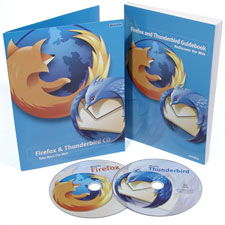


![[Question mark]](fx-questionmark.png) Introductions
Introductions
![[Andrew Turnbull Mozilla Network logo]](../box-mn.png)
Q: What is "The Andrew Turnbull Mozilla Network?"
A: This is a website devoted to general and historical information, advocacy, and resources for Mozilla Firefox and other, related Internet software. It is part and parcel of The Andrew Turnbull Network, my rinky-dink personal website.

Q: Why, oh why, did you create this site?
A: Probably a variety of intertwined factors, to be perfectly honest, stemming from my original interests in computers and Internet technology seeded long ago. I overwhelmingly preferred Netscape Navigator to Microsoft Internet Explorer in the "browser wars." I want to see the Mozilla (née Netscape) browser succeed, so creating a website of related content seemed to me the least that I could do. Over the years, I accumulated a fair amount of knowledge and assorted information that wanted to share with others. Besides, it's a lot of fun!
![[Mozilla Firefox screenshot]](fxshot-small.png)
A: Mozilla Firefox is a web browser. It is free, secure, technologically advanced, and available for several platforms. Firefox uses a rendering engine known as "Gecko."
![[Mozilla Thunderbird screenshot]](tbshot-small.png)
Q: What is Mozilla Thunderbird?
A: Mozilla Thunderbird is an e-mail and newsgroup client program. While it is a separate program from Firefox and can be mixed and matched with any browser, it complements it quite nicely. At the risk of sounding like a broken record, it is also free, secure, technologically advanced, and available for several platforms.
![[SeaMonkey screenshot]](seamonkey291.png)
A: SeaMonkey is a free, secure, cross-platform, and full-featured suite of integrated Internet applications consisting of a web browser, an e-mail client, an HTML editor, and Chatzilla; an IRC client. It used the Gecko rendering engine.
SeaMonkey was marketed as "Mozilla 1.x" until 2006, and if you used Netscape 4, 6, or 7 back in the day you'll feel right at home here. SeaMonkey is developed in parallel with Firefox, and is probably the better choice if you'd rather use your software productively for years on end than be in a constant game of standing guard as user interfaces and version numbers replace themselves.
![[real Sea Monkey]](realseamonkey.jpg)
A: For those who may be curious, the name itself actually has a fairly lengthy back story. A Sea-Monkey is a hybrid breed of brine shrimp; a crustacean found in saline lakes. In 1962, Harold von Braunhut began selling brine shrimp hatching kits as "Sea-Monkeys" and marketing them through comic book ads. Three decades later, a TV show called The Amazing Live Sea-Monkeys aired on CBS.
It can only be supposed that these popular-culture artifacts were on the minds of Netscape employees in the late 1990s. When the Mozilla open-source project was created in 1998, the resulting project needed a codename...and the name picked was "Seamonkey," keeping in the spirit of unusual and fantastic creatures that had spawned "Mozilla" to begin with.
![[SeaMonkey logo]](seamonkey96.png)
In March 2005, Mozilla rationalized its development strategy by discontinuing Mozilla 1.x as an official project and concentrating on Firefox instead. The older-style browser still had plenty of fans, though...and after a few tense moments, it was elected to continue it as a volunteer project. The old codename was promoted to be the "real" name...and in January 2006, SeaMonkey 1.0 was released.
Photo by DaMongMan / Creative Commons.
![]()
![]()
![]()
Q: What other Mozilla software products are there?
A: Camino, a standalone web browser developed exclusively for Macintosh computers running Mac OS X. Advantages Camino has over SeaMonkey or Firefox include an OS X-native "Cocoa" user interface and improved performance. Rest in peace, Camino.
Sunbird, a calendaring application.
Minimo (since eclipsed by Mobile Firefox), a browser for PDAs and "smart" cellular phones.
Bugzilla, a bug-tracking tool intended for use in software development.
In addition there are a large number of other major and minor browsers, many developed outside of Mozilla.org, that use the same technology as Mozilla Firefox as their basis.
Q: What is the Mozilla Organization/Foundation/Corporation?
![[Mozilla star]](mozillastar.png)
A: The Mozilla Organization started in 1998 as an informal group within Netscape concerned with development of the next Netscape browser, which was being developed as an open-source product.
This arrangement continued until July 2003, when AOL (in their infinite wisdom) dissolved the Netscape development team. Some of the assets were spun off and the Mozilla Organization was promptly reorganized as the Mozilla Foundation, a non-profit organization.
In August 2005, a bit more corporate reorganization resulted in the Mozilla Corporation, a subsidiary of the still-extant Mozilla Foundation set up for financial reasons, and now responsible for the development and promotion of Firefox and Thunderbird. As if that wasn't complicated enough, other software (including SeaMonkey) remains under the scope of the Foundation only.
If your head hurts, don't worry. Most of the time, these distinctions aren't important enough for most people to need to care about.
![[Question mark]](fx-questionmark.png) Looking into the past
Looking into the past
![[Browser tree]](browser_tree.gif)
Q: What is the history and/or genealogy of Mozilla Firefox?
A: The short version...
Netscape begat Mozilla. You can't separate one from the other if you try.
The long version...
In 1993, developers at the National Center for Supercomputing Applications in Illinois created Mosaic; generally credited as the first graphical web browser.
One year later, Jim Clark raided the NCSA for talent and created a new company that would build an improved browser and bring the world wide web into the mainstream. So it went, and the first public version of Netscape Navigator came out in October 1994.
"Mozilla" originated as the codename for Netscape Navigator. The word was appropriated as the name of Netscape's lizard mascot, and was contained in Netscape's user agent string.
Netscape competed on its own merits and enjoyed near-90% usage share for a time. Microsoft aggressively exploited bundling and illegal marketing practices to push Internet Explorer, after belatedly realizing the Internet existed. By February and March 1998, Netscape was fighting to survive...and in the interest of survival, they openly released the source code to their browser for the first time. This was the start of the Mozilla project: Netscape's next browser, developed in open source.
Over the next four years, the Netscape code was heavily rewritten and a series of alpha- and beta-grade software builds were released under the "Mozilla" name. With a bit of spit and polish, these served as the basis for Netscape 6 and Netscape 7. This lineage never really died, since it developed into the SeaMonkey releases of today.
In 2002, a project called Phoenix branched off with the goal of reducing the perceived codebloat of Mozilla and refining the interface to be more intuitive and customizable. In February 2004, this project was christened Firefox. The rest, as they say, is history.
Be sure to see the Visual Browser History for a more in-depth look at the development and transition between Netscape 4.x and Mozilla Firefox!
![[Oh no, not Netscape 6]](netscape6splash-sm.png)
A: A lot can change in a few months of software time, and most of the bugs of Netscape 6.0 were moot by the time Netscape 6.2 came out a year later. Now it's been 14 years, and . . . well, at least we can be assured that the problems users have with their browsers today owe nothing to Netscape 6!
 A: Not any more. Mozilla had commercially-pressed CD-ROMs and printed "guidebooks" available from their online store in the mid-2000s timeframe, but they didn't seem to last long. Rapid obsolescence seems the foe to blame here: Woe be you if Mozilla 1.7.1 and 1.7.2 are already out before your 1.7.0 CD arrives in the mail...
A: Not any more. Mozilla had commercially-pressed CD-ROMs and printed "guidebooks" available from their online store in the mid-2000s timeframe, but they didn't seem to last long. Rapid obsolescence seems the foe to blame here: Woe be you if Mozilla 1.7.1 and 1.7.2 are already out before your 1.7.0 CD arrives in the mail...
(Incidentally, Mozilla doesn't have an online store at all anymore. Damn, how am I going to get my T-shirt fix?)
![[Question mark]](fx-questionmark.png) Availability and Compatibility
Availability and Compatibility
Q: What are the system requirements for Firefox and other Mozilla software?
A: When my personal interest in Firefox was at its zenith, approximate system requirements were as follows:

![[No sub-XP users allowed]](no_firefox_for_you.png)
Alas, none of these are true anymore.
Q: Will Mozilla Firefox or Mozilla Thunderbird run on Windows 95 or other older versions of Windows?
![[Firefox on Windows 95]](firefox-sm303.png)
A: If you aren't picky about being current, the answer is "yes:" Versions up to 1.5.0.12 run on IE-free Windows 95 out-of-the-box; no hacks necessary!
The conditions are relatively minor, and mainly impact systems that have never seen an update in their lives: Version 2.30.4265 or greater of the system file OLEAUT32.DLL (implemented in both the Windows Library Update and Visual Basic 6.0 run-time files; take your pick) is all that's needed. The DCOM95.EXE update might also be needed on pre-OSR2 systems.
Unfortunately, Mozilla Firefox 2 featured a small Unicode API change that caused the browser to freeze or crash upon startup by default, and 3.0 and later versions featured MSVC80 DLLs that permanently torched the bridge with the past. Oh well; it was fun while it lasted.
![[Classilla]](classilla.png)
A: Unfortunately, Firefox never existed for Mac OS 9. Owe it up to bad timing: Mozilla's Mac developers started focusing exclusively on OS X around December 2002, and the betas of what would become Firefox didn't start being ported to all platforms until May 2003.
The pre-Firefox Mozilla application suite was made available for the "classic" Mac OS through version 1.2.1; as was Netscape through version 7.02. These versions are compatible with Mac OS 8.5 to 9.2.2.
Although official development of Mozilla releases for Mac OS 9.2.2 and earlier versions was discontinued in early 2003, the trail didn't go entirely cold. Third-party builds of Mozilla 1.3 were made available. Today this development continues in the guise of Classilla, which is about as good a browser on Mac OS 9 as you're going to get.
Q: Enough! Just tell me what the newest browser that works on my operating system is.


A: OK, it's table time:
| OS | Firefox | SeaMonkey | Third-party builds |
|---|---|---|---|
| Windows 95 & NT | Firefox 1.5.0.12 | SeaMonkey 1.1.17 | Firefox 2.0.0.22pre, SeaMonkey 1.1.20pre |
| Windows 2000 | Firefox 3.6.28, 12 | SeaMonkey 2.9.1 | - |
| Mac OS 8 & 9 | - | Mozilla 1.2.1 | Classilla |
| PowerPC Mac OS X | Firefox 3.6.28 | SeaMonkey 2.0.14 | TenFourFox |